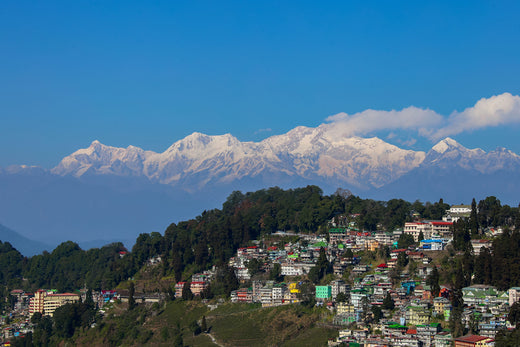India is the second-largest tea producer in the world, right after China. That is reason enough to dedicate an article to this country. Don’t you agree? Join us as we explore India's rich tea history, and the integral role tea plays in Indian culture.
India – The Land of Tea
The roots of Indian tea culture stretch deep into the past. Long before European settlers recognized India’s potential as a tea producer, the native variety Camellia Assamica flourished, enjoyed by locals as tea. Even today, a significant portion of tea is consumed domestically, with Masala Chai—a spiced tea often using black tea as a base—at the heart of this vibrant tea tradition.
India’s tea landscapes are scattered across the country, each region boasting unique growing conditions. Many popular tea varieties are named after their places of origin, often protected for their distinct qualities.
Famous Indian Tea Regions
India is home to some of the world’s most renowned tea-growing areas, and many tea varieties proudly carry their regional names. Assam and Darjeeling are not just names; tea enthusiasts recognize in specialty shops—they have also made their way to everyday supermarket shelves.
The unique flavors of Indian teas are linked to their specific origins. From the misty tea gardens tucked into the Himalayas’ slopes in Darjeeling, rising to 2,000 meters, to Assam's warm, tropical climate producing robust, malty teas, and on to the fragrant fields of the south in Nilgiris, the diversity is immense. There are also lesser-known yet equally impressive tea gardens in regions like Dooars, Sikkim, and Kangra.
To clarify a common misconception: Ceylon tea does not come from India but from Sri Lanka, formerly known as Ceylon.

The Art of Tea Harvesting
Making good tea is an art. It starts with the careful picking of tea leaves. The timing of the harvest plays a crucial role in defining the flavor characteristics of the tea.
The spring harvest, or First Flush, is especially coveted. The tea plant has just awakened from its winter slumber, and its fresh, tender shoots impart a delicate aroma to the brew.
Following the First Flush is the Second Flush, the summer harvest. Leaves are more mature by this point, having had more time on the plant, leading to a brew that often has a deeper, more robust flavor.
Interestingly, the Second Flush is not the actual second harvest; between spring and summer, many regions experience a smaller In-Between Flush. Similarly, the Third Flush, the autumn harvest, is technically the fifth harvest due to the Monsoon Flush occurring during the heavy rains in areas like Darjeeling and Assam.

The Taste of Indian Tea
So, how does Indian tea taste? The answer is simple—it varies! While India is primarily known for its black teas, which themselves have varied flavor profiles, other top-quality teas are also produced there.
The Most Popular Indian Teas
At the heart of Indian tea culture is Masala Chai, a spiced tea often brewed with black tea, milk, and sugar. In India, it fills the streets with its scent and is simply part of everyday life.

Darjeeling black tea is known among enthusiasts as the “champagne of teas,” celebrated for its exquisite, delicate flavor with gentle floral notes.
Assam black tea is another flagship of Indian tea quality. Known for its robust, malty character, this variety is enjoyed in its pure form or as a base for various blends.
Indian green teas and oolongs from regions such as Darjeeling, Assam, and the Nilgiri Hills are also a delight, showcasing the masterful skills of Indian tea makers, though they are rarer than black teas.
Brewing Your Perfect Cup of Indian Tea
When brewing a pure black tea like Darjeeling or Assam, use the right water temperature, a proper amount of leaves, and a timer to achieve the perfect steeping time. Of course, you can experiment with these variables to tailor your tea to your taste, whether you prefer it milder or stronger.
To prepare Indian chai, use a spicy tea blend or fresh spices, which you should simmer with black tea in a pot. Since this method requires some practice and precision, a ready-made blend assures a balanced, flavorful experience. Our HARIMAN CLASSIC CHAI combines quintessential spices like cinnamon, cardamom, ginger, fennel, and cloves with richly full-bodied, malty Assam black tea. Refine the brew with milk and sugar for a delicious, creamy cup.

Indian Tea – A Journey Through History and Culture
How long the art of tea-making has been practiced in India remains shrouded in history. However, we do know that the European discovery of the Indian tea plant was thanks to the Scottish adventurer Robert Bruce. Around 1827, a local chieftain brought the indigenous plant to his attention, leading to European trading companies introducing the Camellia Sinensis from China to India.
This was a strategic move for the British, who realized that tea thrived not only in China and Japan but also in India. To reduce dependency on Chinese tea, they quickly promoted tea cultivation in India. Introducing the Chinese tea plant Camellia Sinensis was crucial, as Camellia Assamica thrives only in very warm and humid conditions, which are not available everywhere in India. Its Chinese sister, however, is more adaptable and is cultivated in various other Indian tea-growing areas.
In India, tea is far more than a beverage—it is a social ritual that brings people together, offering space for conversation and small moments of respite from the hustle of everyday life. Sharing tea time is an expression of mutual appreciation.
Exquisite Enjoyment of Indian Teas – Our Selection
If your curiosity has been piqued and you would like to taste Indian teas yourself, here are some of our favorites for you to try:
Our Second Flush Darjeeling MUSE offers the richly full-bodied taste of the summer harvest along with floral, fruity, and sweet muscatel notes reminiscent of muscat grapes. Our exquisite specialty QUEEN'S GRACE is a first flush Darjeeling from the spring harvest that will enchant you with its fresh, delicate flavor and floral notes, derived from only the youngest, most tender shoots and buds. If you prefer a robust, malty experience, our Assam NANDANA will delight you with its sweet caramel notes. There is so much to explore in the world of tea! No matter which tea you choose, one thing is certain: an exciting journey through aromatic flavors and fascinating stories awaits you.





























